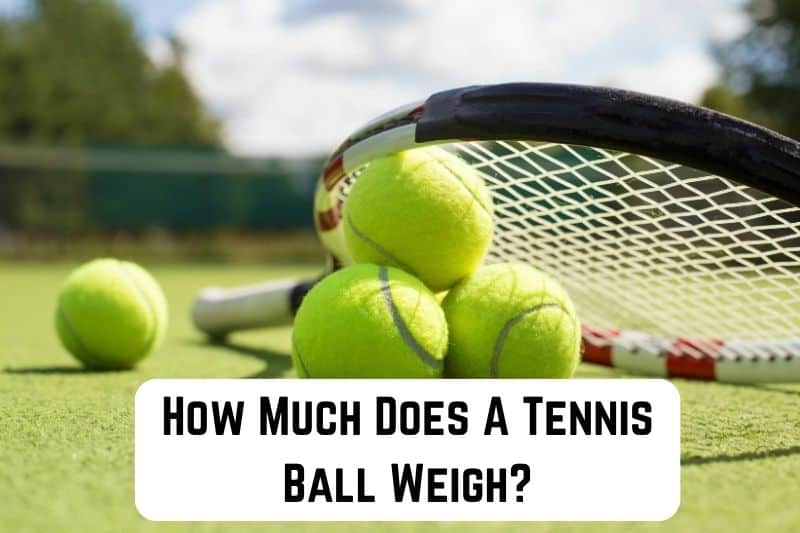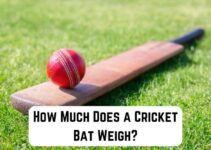When you watch a tennis match, have you ever wondered how much a tennis ball weighs? Knowing the weight of a tennis ball can be quite interesting, especially if you play the sport or are a fan. It may even help refine your game and provide some valuable insight.
Tennis balls are typically made of rubber, hollowed and pressurized with air to provide a uniform bounce on the court. The International Tennis Federation (ITF) sets certain standards to ensure consistent and fair gameplay.
This article explores the specific weight standards the ITF sets for tennis balls and the factors that can affect these weights. So, grab your racket, and let’s dive into the world of tennis ball weight!
Read: How Much Does a Feather Weigh? (Quick Answer)
According to the International Tennis Federation (ITF), the official tennis ball must have a mass of 56.0–59.4 grams (1.975–2.095 ounces) and a diameter between 6.54–6.86 centimeters (2.575–2.700 inches).
Measuringly.com
Size and Weight Standards
Official Tennis Ball Regulations
When you’re playing tennis, it’s important to understand the size and weight standards for the ball you’re using. According to the International Tennis Federation (ITF), the official tennis ball must have a mass of 56.0–59.4 grams (1.975–2.095 ounces) and a diameter between 6.54–6.86 centimeters (2.575–2.700 inches). These regulations help ensure consistency and fairness in matches.
The tennis ball’s exterior is typically made of felt-like material, while the interior is either pressurized or non-pressurized rubber. Pressurized balls tend to provide more bounce and speed, making them ideal for competitive play. In contrast, non-pressurized balls are better suited for recreational play as they have a longer lifespan.
Weight Variations
While the official tennis ball’s weight is regulated, you may come across balls with slight variations in weight. These variations can affect your game and the ball’s trajectory.
- Extra Duty: These balls have a thicker and denser felt covering, making them slightly heavier than regular tennis balls. They are suitable for hard court surfaces as they provide more durability.
- Regular Duty: These balls have a thinner felt covering, making them lighter and more comfortable on softer court surfaces such as clay or grass.
Consider your playing surface and skill level to choose the appropriate ball based on weight variations. Maintaining consistency with the type of ball you use in practice and matches can help improve your overall performance. Always check the specifications of the ball you’re using and choose one that aligns with your needs and play style.

Materials and Construction
Core Material
The core material of a tennis ball plays a vital role in determining its weight. Generally, tennis ball cores are made from a rubber compound. This rubber compound consists of natural rubber, butadiene rubber or a blend of both, which gives the ball its bounce and durability.
To make the core even lighter, manufacturers sometimes inject air or other gases into the rubber to form a pressurized core. This helps maintain the ball’s liveliness over time.
Exterior Specifications
On the outside, a tennis ball has a felt cover affecting its weight and performance. The felt is typically composed of wool, nylon, or a blend of both materials.
During manufacturing, fibers are interlocked to create a smooth, fuzzy surface that enables the ball to grip the racket’s strings better while also providing good aerodynamic properties.
As for the weight of a tennis ball, the average weight falls between 56.7 and 58.5 grams (2 to 2.1 ounces). The International Tennis Federation (ITF) has established specific guidelines to ensure the consistency of tennis balls used in professional play. According to ITF regulations, a common tennis ball must weigh between 56.0 and 59.4 grams (1.98 to 2.10 ounces).
A summary of ITF tennis ball specifications is provided below:
| Specification | Minimum | Maximum |
|---|---|---|
| Mass | 56.0 g | 59.4 g |
| Size (diameter) | 6.54 cm | 6.86 cm |
| Bounce (from 254 cm) | 135 cm | 147 cm |
| Forward deformation | 0.56 cm | 0.74 cm |
| Return deformation | 0.80 cm | 1.08 cm |
In conclusion, the materials used in a tennis ball’s construction, such as the core material and exterior specifications, are crucial factors that determine its weight. By understanding these materials and manufacturing processes, you can ensure that the tennis balls you use adhere to the weight standards set by the International Tennis Federation.

Impact on GamePlay
Bounce Effects
While playing tennis, it’s essential to understand how a tennis ball’s weight affects how it bounces and reacts on the court. A heavier ball usually results in a lower bounce, whereas a lighter ball can produce a higher bounce. This difference in bounce can influence your playing strategy and the type of shots you use during a game.
By knowing the weight of a tennis ball, you can adjust your grip, positioning, and swing to adequately control the ball and increase the precision of your shots. A tennis ball weighing around 56 to 59.4 grams is considered optimal for gameplay, providing a consistent bounce and allowing players to maintain fast-paced rallies.
Read: How Much Does a Sousaphone Weigh? (Answered)
Flight Dynamics
Another critical aspect in which tennis ball weight can impact the game is in flight dynamics. The speed and trajectory of the ball in mid-flight depend heavily on the weight of the ball.
A lightweight ball travels through the air at a slower speed and is more susceptible to changes in direction due to wind or spin. On the other hand, a heavier ball zips through the air faster and is less affected by external factors.
As you get used to playing with tennis balls of varying weights, you can master the effects of weight on ball flight. This mastery will help you develop a playing style that works best for you and improve your overall performance on the tennis court. Remember, practicing with diverse tennis ball weights can enhance your adaptability and agility, ultimately refining your skills in the long run.







